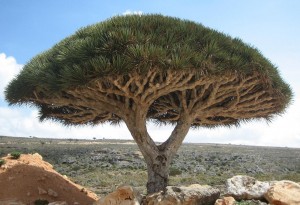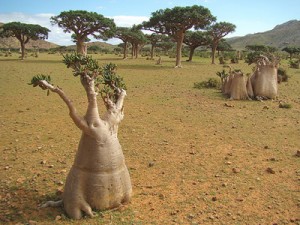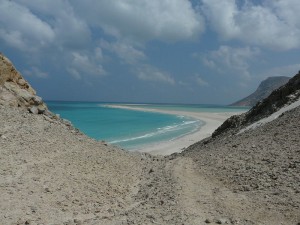It’s incredible how many places get (re)discovered even today, thus becoming little by little known to traveler’s around the world. Some of these places have lain forgotten for decades, sometimes even centuries, without anyone but the locals paying any attention to them. Such is the case of Socotra, a little island off the coast of the Indian Ocean, an offshore territory belonging to Yemen. Socotra is without a doubts one of the most amazing places on earth, similar to no other place on this planet.
 One of the first things that make Socotra unique is its biodiversity. One third of the plant species found on Socotra cannot be found anywhere else on earth, for one. Everything looks so different than what you’re used to that if you woke up one morning and found yourself on Socotra, you’d probably think that you had been kidnapped by aliens. Socotra has a special, otherwordly beauty that cannot even be put into words. Species like the desert rose (also known as the elephant foot, because it actually looks like the foot of an elephant with pretty pink flowers on top), or the Dragon’s Blood tree, which is more similar to a kid’s drawing of a tree than a real life tree, or the strange looking cucumber tree (whose trunk, obviously, looks like a cucumber). One species of Socotran fig tree doesn’t even need any soil to grow on, it simply pushes its roots through the rock.
One of the first things that make Socotra unique is its biodiversity. One third of the plant species found on Socotra cannot be found anywhere else on earth, for one. Everything looks so different than what you’re used to that if you woke up one morning and found yourself on Socotra, you’d probably think that you had been kidnapped by aliens. Socotra has a special, otherwordly beauty that cannot even be put into words. Species like the desert rose (also known as the elephant foot, because it actually looks like the foot of an elephant with pretty pink flowers on top), or the Dragon’s Blood tree, which is more similar to a kid’s drawing of a tree than a real life tree, or the strange looking cucumber tree (whose trunk, obviously, looks like a cucumber). One species of Socotran fig tree doesn’t even need any soil to grow on, it simply pushes its roots through the rock. But the plants are only part of what makes Socotra special. It’s probably needless to say that the landscapes on the island are simply amazing. Unfortunately, there are next to no roads on the islands. Granted, not many people live on Socotra (about 40,000 people, the population of a small town), so maybe roads were not an imperative in the past, but since the island was declared a World Heritage Site, UNESCO has been trying to convince the Yemen government to invest more in their natural treasure.
But the plants are only part of what makes Socotra special. It’s probably needless to say that the landscapes on the island are simply amazing. Unfortunately, there are next to no roads on the islands. Granted, not many people live on Socotra (about 40,000 people, the population of a small town), so maybe roads were not an imperative in the past, but since the island was declared a World Heritage Site, UNESCO has been trying to convince the Yemen government to invest more in their natural treasure. There are beaches in Socotra, but no resorts, bars or restaurants, or even beach-goers, at that. Eco-tourism is the word of the day in Socotra, and efforts are being made to preserve both the local ecosystems and the traditional way of life and the customs of the people. Environmentalists are rejoicing that only a couple of thousand tourists visit Socotra every year, therefore the chances of damaging the ecosystem are much slimmer. The only thing holding back the masses of travelers is probably the troubled situation in Yemen, but hopefully that will change in the near future and all willing eco-tourists will get the chance to visit this mesmerizing place.
There are beaches in Socotra, but no resorts, bars or restaurants, or even beach-goers, at that. Eco-tourism is the word of the day in Socotra, and efforts are being made to preserve both the local ecosystems and the traditional way of life and the customs of the people. Environmentalists are rejoicing that only a couple of thousand tourists visit Socotra every year, therefore the chances of damaging the ecosystem are much slimmer. The only thing holding back the masses of travelers is probably the troubled situation in Yemen, but hopefully that will change in the near future and all willing eco-tourists will get the chance to visit this mesmerizing place.FEATURED BY:
MS. MIKA AOYUKI
PROSPER CO., LTD JAPAN
+81 50 5539 9816
mika@prosperjp.com